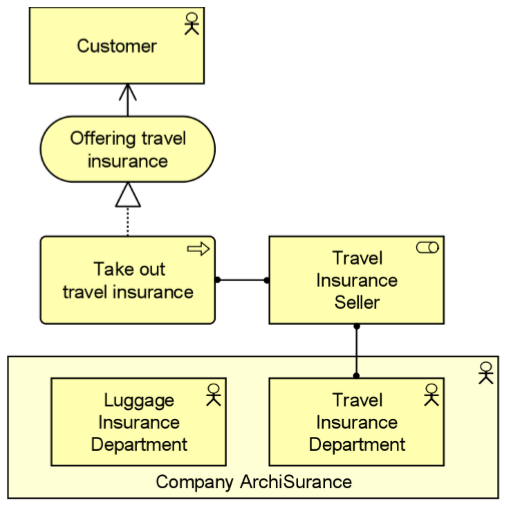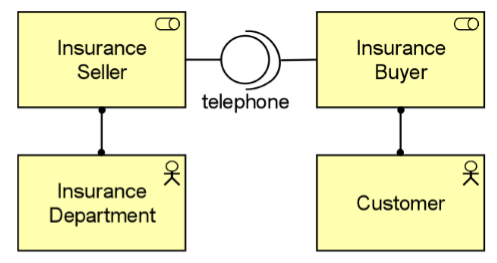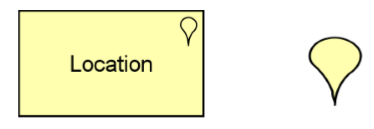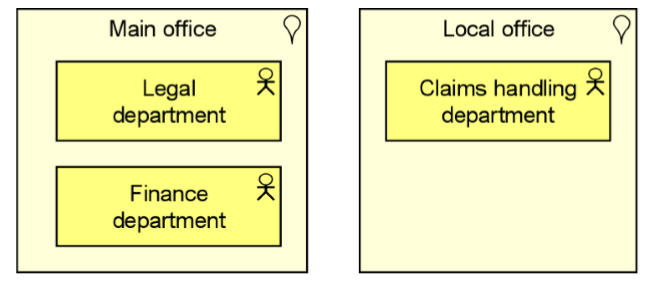The structure aspect at the business layer refers to the static structure of an organization, in terms of the entities that make up the organization and their relationships.
Two types of entities are distinguished: Activity and passive entities
Active Entity – Perform some behavior such as business process or functions, they are be individual, Group of People or long-term, or more permanent resources
- business actors
- business roles
- individual persons (e.g., customers or employees)
- groups of people (organization units)
Passive entities (also called business objects) – are manipulated by behavior such as business processes or functions.
- Business Process
- Business Function
Structural Concepts
Business Actor
A business actor is defined as an organizational entity that is capable of performing behavior by assigning to (one or more) business roles. A business actor is an organizational entity as opposed to a technical entity. The name of a business actor should preferably be a noun.

Actors may include entities outside the actual enterprise, such as, customers and partners.
Business Actor Example:
The ArchiMate Diagram below illustrates the use of business actors.:
- The company ArchiSurance is modeled as a business actor that is composed of two departments.
- The Travel insurance seller role is assigned to the travel department.
- In this role, the travel department performs the Take out insurance process, which offers a service that is accessible via the business interface assigned to this role.

Business Role
A business role is defined as the responsibility for performing specific behavior, to which an actor can be assigned. A business role may be assigned to one or more business processes or business functions, while a business actor may be assigned to a business role.

Business Role Example in ArchiMate
In the ArchiMate Diagram below, the business role Insurance Seller is fulfilled by the Insurance Department actor and has telephone as a provided interface. The business role Insurance Buyer is fulfilled by the Customer actor, and has telephone as a required interface.

Business Collaboration
A business process or function may be interpreted as the internal behavior assigned to a single business role. In some cases behavior is the collective effort of more than one business role; in fact a collaboration of two or more business roles results in collective behavior which may be more than simply the sum of the behavior of the separate roles.

Business Collaboration Example
The ArchiMate Diagram below illustrates a possible use of the collaboration concept. In this example, selling an insurance product involves the Sales department, fulfilling a sales support role, and a department specialized in that particular type of insurance, fulfilling an insurance seller role. The example also shows that one role, in this case Sales support, can participate in more than one collaboration.

Business Interface
A business interface may be assigned to one or more business services, which means that these services are exposed by the interface. A business interface is defined as a point of access where a business service is made available to the environment. The name of a business interface should preferably be a noun.
Business Interface Example:
In the ArchiMate Diagram below, the business services provided by the Luggage insurance seller and its collaboration with the Medical insurance seller are exposed by means of a web form and call center business interface, respectively.

Location
The location concept is used to model the distribution of structural elements such as business actors, application components, and devices. This is modeled by means of an assignment relationship from location to structural element. Indirectly, a location can also be assigned to a behavior element, to indicate where the behavior is performed.

Location Example
The ArchiMate Diagram below shows that the departments of an insurance company are distributed over different locations. The Legal and Finance departments are centralized at the main office, and there are claims handling departments at various local offices throughout the country.

Business Object
Business objects represent the important “informational” or “conceptual” elements in which the business thinks about a domain. Generally, a business object is used to model an object type, of which several instances may exist within the organization. A wide variety of types of business objects can be defined. Business objects are passive in the sense that they do not trigger or perform processes.

Note:
- Business objects may be accessed by a business process, function, a business interaction, a business event, or a business service.
- A business object may have association, specialization, aggregation, or composition relationships with other business objects.
- A business object may be realized by a representation or by a data object (or both). The name of a business object should preferably be a noun.
Business Object Example
The model below shows a business object Invoice, which aggregates (multiple) business objects Invoice line.
The business process – Create invoice creates the invoice and the invoice lines, while the business process Send invoice accesses the business object Invoice.

Two possible realizations of this business object exist:
- an Electronic invoice (data object)
- a Paper invoice (representation).